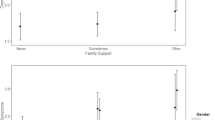Abstract
Coyne's (1976b) interpersonal theory of depression postulated that the combination of depressive symptoms and excessive reassurance-seeking leads to interpersonal problems (e.g., loneliness, devaluation). The present study is one of the first to test this model among youth, particularly a clinical sample of youth. Sixty-eight youth psychiatric inpatients (35 girls; 33 boys; mean age = 13.34 years, SD = 2.50) completed self-report measures of excessive reassurance-seeking, depressive symptoms, and interpersonal rejection. Results conformed to the hypothesis: The statistical interaction of excessive reassurance-seeking and depressive symptoms predicted interpersonal rejection, such that high-reassurance-seeking youth with depressive symptoms reported the most interpersonal rejection. Implications of the findings for interpersonal theory of depression in youngsters are discussed.
Similar content being viewed by others
REFERENCES
Clark, L. A., & Watson, D. (1991). Tripartite model of anxiety and depression: Psychometric evidence and taxonomic implication. Journal of Abnormal Psychology, 100, 316–336.
Cohen, J., & Cohen, P. (1983). Applied multiple regression/correlation analysis for the behavioral sciences (2nd ed.). Hillsdale, NJ: Erlbaum.
Coyne, J. C. (1976a). Depression and the response of others. Journal of Abnormal Psychology, 85, 186–193.
Coyne, J. C. (1976b). Toward an interactional description of depression. Psychiatry, 39, 28–40.
Faust, J., Baum, C. G., & Forehand, R. (1985). An examination of the association between social relationships and depression in early adolescence. Journal of Applied Developmental Psychology, 6, 291–297.
Garber, J., & Hollon, S. D. (1991). What can specificity designs say about causality in psychopathology research? Psychological Bulletin, 110, 129–136.
Gotlib, I. H., & Robinson, L. A. (1982). Response to depressed individuals: Discrepancies between self-report and observerrated behavior. Journal of Abnormal Psychology, 91, 231–240.
Joiner, Jr., T. E. (1994). Contagious depression: Existence, specificity to depressed symptoms, and the role of reassurance-seeking. Journal of Personality and Social Psychology, 67, 287–296.
Joiner, Jr., T. E., Alfano, M. S., & Metalsky, G. I. (1992). When depression breeds contempt: Reassurance-seeking, self-esteem, and rejection of depressed college students by their roommates. Journal of Abnormal Psychology, 101, 165–173.
Joiner, Jr., T. E., & Barnett, J. (1994). A test of interpersonal theory of depression in children and adolescents using a projective technique. Journal of Abnormal Child Psychology, 22, 595–609.
Joiner, T. E., Jr., Catanzaro, S., & Laurent, J. (1996). The tripartite structure of positive and negative affect, depression, and anxiety in child and adolescent psychiatric inpatients. Journal of Abnormal Psychology, 105, 401–409.
Joiner, Jr., T. E., Katz, J., & Lew, A. (1997). Self-verification and depression among youth psychiatric inpatients. Journal of Abnormal Psychology, 106, 608–618.
Joiner, Jr., T. E., Katz, J., & Lew, A. (in press). Harbingers of depressotypic reassurance-seeking: Increased anxiety, decreased self-esteem, and negative life events. Personality and Social Psychology Bulletin.
Joiner, Jr., T. E., & Metalsky, G. I. (1995). A prospective test of an integrative interpersonal theory of depression: A naturalistic study of college roommates. Journal of Personality and Social Psychology, 69, 778–788.
Joiner, Jr., T. E., & Metalsky, G. I. (1998). Reassurance-seeking: Delineating a risk factor involved in the pathogenesis of depression. Manuscript submitted to publication.
Joiner, Jr., T. E., & Schmidt, N. B. (in press). Excessive reassurance-seeking predicts depressive but not anxious reactions to acute stress. Journal of Abnormal Psychology.
Joiner, Jr., T. E., Schmidt, K. L., & Schmidt, N. B. (1996). Low-end specificity of childhood measures of emotional distress: Differential effects for depression and anxiety. Journal of Personality Assessment, 67, 258–271.
Jöreskog, K. G, & Sörbom, D. (1989). LISREL 7: A guide to the program and applications (2nd. ed.). Chicago: Statistical Package for the Social Sciences.
Katz, J., & Joiner, Jr., T. E. (in press). Contagious depression among dating couples: The roles of reassurance-seeking and intimacy. Journal of Social and Clinical Psychology.
Kovacs, M. (1992). Children's Depression Inventory manual. Los Angeles: Western Psychological Services.
Laurent, J., Potter, K., & Catanzaro, S. J. (1994, March). Assessing positive and negative affect in children: The development of the PANAS-C. Paper presented at the 26th annual convention of the National Association of School Psychologists, Seattle, WA.
Lonigan, C. J., Carey, M. P., & Finch, A. J., Jr. (1994). Anxiety and depression in children and adolescents: Negative affectivity and the utility of self-reports. Journal of Consulting and Clinical Psychology, 62, 1000–1008.
Mullins, L. L., Peterson, L., Wonderlich, S. A., & Reaven, N. M. (1986). The influence of depressive symptomatology in children on the social responses and perceptions of adults. Journal of Child Clinical Psychology, 15, 233–240.
Nolen-Hoeksema, S., & Girgus, J. S. (1994). The emergence of gender differences in depression during adolescence. Psychological Bulletin, 115, 424–443.
Peterson, L., Wonderlich, S., Reaven, N. M., & Mullins, L. L. (1987). Adult educators' response to depression and stress in children. Journal of Social and Clinical Psychology, 5, 51–58.
Potthoff, J. G., Holahan, C. J., & Joiner, Jr., T. E. (1995). Reassurance-seeking, stress generation, and depressive symptoms: An integrative model. Journal of Personality and Social Psychology, 68, 664–670.
Swann, W. B., Wenzlaff, R. M., Krull, D. S., & Pelham, B. W. (1992). Allure of negative feedback: Self-verification strivings among depressed persons. Journal of Abnormal Psychology, 101, 293–305.
Vosk, B., Forehand, R., Parker, J. B., Rickard, K. (1982). A multimethod comparison of popular and unpopular children. Developmental Psychology, 18, 571–575.
Watson, D., Clark, L. A., & Carey, G. (1988). Positive and Negative Affectivity and their relation to anxiety and depressive disorders. Journal of Abnormal Psychology, 97, 346–353.
Watson, D., Clark, L. A., & Tellegen, A. (1988). Development and validation of brief measures of positive and negative affect: The PANAS scales. Journal of Personality and Social Psychology, 54, 1063–1070.
Author information
Authors and Affiliations
Corresponding author
Rights and permissions
About this article
Cite this article
Joiner, T.E. A Test of Interpersonal Theory of Depression in Youth Psychiatric Inpatients. J Abnorm Child Psychol 27, 77–85 (1999). https://doi.org/10.1023/A:1022666424731
Issue Date:
DOI: https://doi.org/10.1023/A:1022666424731




